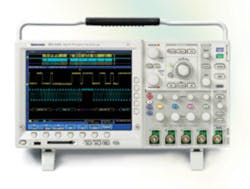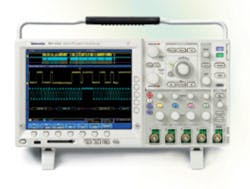Lots of scopes have long memories these days, but how do you find anything in all that data? Well, the new Tektronix DPO4000 not only comes with a standard 10-M record length on all channels, but it also includes the Wave Inspector feature that facilitates using the long memory.
As comprehensive as the jog/shuttle control is, the real power of Wave Inspector is in the intelligent search department. You can select search criteria from a list of event types.
For example, how about finding occurrences of fall times greater than 10 ns? All parts of the acquired signal that satisfy this criterion will be marked automatically. Similarly, if you manually identify anomalies as you pan and zoom, these, too, can be marked. You move through the acquired data from one mark to another via the previous and next buttons. Marks can define the range of cursor measurements, for example.
In addition to rise or fall time, events include edges, pulse width, runt pulses, logical combinations of channels, and setup and hold timing. If these items look like trigger types, they are. In fact, you can copy trigger settings to Wave Inspector�s search criteria or vice versa.
Typically, you�re looking for a straightforward condition, but sometimes the system under test doesn�t work as expected. You can mark all the basic events and search through them to find the few where something else is influencing operation. Now you can narrow the search criteria to identify only those errant events that cause the system to malfunction. Triggering on the search criteria is a means of capturing the system�s operation before and after the malfunction.
With such a long standard memory, acquiring serial bus data is a natural application for the DPO4000. Of course, you could pan and zoom to find each remote frame in CAN bus data or missing acknowledgements on an I2C bus, but that would be error-prone and take a very long time. Instead, using the optional serial triggering and analysis software, the content of each CAN, I2C, or SPI packet is decoded for you, and triggering, searching, and marking can be geared to packet content. You can deal with the information the bus is meant to be carrying instead of being bogged down in the 1-0 physical layer.
This scope has a bus analysis feature. With one instrument you can decode bus activity as well as find the nanosecond glitches that may be affecting it. Before the DPO4000, you needed at least two types of test equipment, and it was guaranteed that they didn�t support cross-domain triggering in the integrated, user-friendly manner accomplished by Wave Inspector.
Like previous DPOs, these scopes provide a short memory mode that features a very high display update rate so that waveform anomalies such as metastable states, runts, and glitches can be observed. Once seen, these aberrations can be programmed as part of the trigger or search criteria.
The DPO4000 Series has four members ranging from the two-channel 350-MHz DPO4032 to the four-channel 1?GHz DPO4104. The 500-MHz DPO4054 and the 350-MHz DPO4034 also are four-channel instruments. All units have a 2.5-GS/s sampling rate per channel except for the DPO4104 with 5 GS/s. DPO4032: $7,000; DPO4034: $8,900; DPO4054: $11,000; DPO4104: $14,000.
FOR MORE INFORMATION
on the DPO4000 Series
www.rsleads.com/604ee-176

